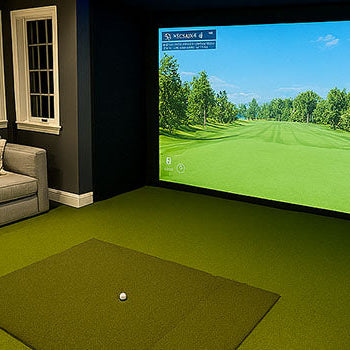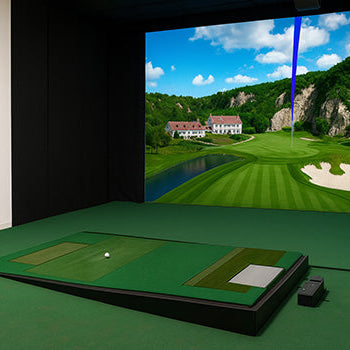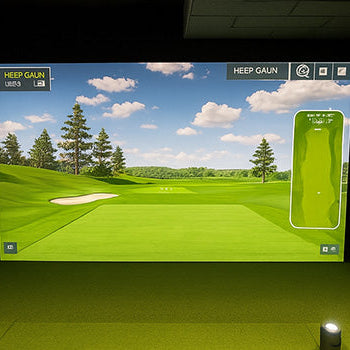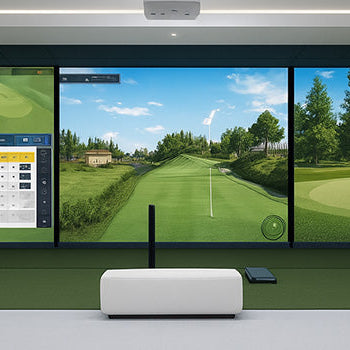Ever shown up to a golf simulator in jeans and flip-flops? Yeah… not your best moment.
Short answer: Wear flexible, breathable clothes and clean, non-spiked shoes. It’s not about impressing anyone with fashion, it’s about swinging comfortably, staying focused, and not getting called out by the simulator staff. Stick around for real-world advice that’ll keep you sharp, confident, and totally simulator-ready.

The Short Answer: There's No Strict Dress Code
Most simulator venues won’t throw you out for wearing the wrong thing, but that doesn’t mean anything goes. Whether you’re practicing golf, flying a simulated jet, or learning to operate machinery, the goal is the same: comfort, mobility, and focus.
You don’t need a polo with a club logo or a full golf outfit. What you do need is gear that moves with you, doesn’t overheat, and won’t get in your way.
If your clothing helps your performance and keeps distractions low, you’ve nailed it.
The Relaxed Atmosphere of Indoor Golf
Indoor golf simulators are designed for comfort. You’re not battling the wind or sun, you’re swinging in a climate-controlled room, often with a drink in one hand between shots.
It’s casual. You don’t need to dress like you’re teeing off at Augusta. That said, looking neat and wearing functional clothing shows you’re taking the experience seriously.
Comfortable, clean, and swing-friendly is the sweet spot.
Why You Can Leave the Spikes and Waterproofs at Home
You're not trudging through damp fairways or unpredictable weather. Indoors means dry turf, clean mats, and no chance of rain ruining your swing.
Leave the waterproofs, jackets, and extra gear at home. You’ll just overheat and look out of place.
Dress for the room, not the rough.
The Golden Rule: Wear Something You Can Comfortably Swing In
If your shirt chokes your follow-through or your trousers grip during a backswing, they’re not the right choice.
Test it before you leave home, can you stretch, twist, and swing freely? That’s your green light.
The key is mobility. Your clothing should enhance, not limit your swing.
Recommended Attire for a Simulator Session
Now that we’ve set the tone, let’s break down what to wear from top to bottom. You don’t need pro gear, but you do need to think practically.
For Your Top Half: Polo Shirts, T-Shirts, or Golf Sweaters
Stick with polos, fitted athletic T-shirts, or lightweight golf sweaters. If the simulator space is a little cooler, layering with a performance long sleeve is fine, as long as it doesn’t restrict movement.
Avoid heavy sweatshirts, baggy hoodies, or dress shirts that limit flexibility.
You want a top that breathes well and stays put while you move.
For Your Bottom Half: Athletic Shorts, Trousers, or Golf Trousers
Leave the jeans at home. They're too stiff, and once you start swinging, you’ll regret it.
Instead, choose breathable joggers, golf trousers, or athletic shorts (if the setting is informal). These options give you the flexibility you need without looking too casual or too overdressed.
The best choice is anything that lets you rotate and bend without resistance.
Why Breathable, Stretchy Fabrics Are Your Best Friend
Even in a cool room, things can heat up mid-session, especially during a long game or swing analysis.
Moisture-wicking materials like polyester blends or dry-fit cotton keep you comfortable. Stretch fabrics are essential, especially for repeated movement and focus on technique.
Stay cool, dry, and mobile, your clothes should work as hard as you do.

The Most Important Consideration: Your Footwear
You can get everything else right, but if your shoes are wrong, you’ll feel it with every swing. Many first-timers ask: “Do I wear golf shoes to a simulator?” The answer depends, but the key rule is always the same: no metal spikes.
Why You Should Wear Trainers (Sneakers)
In most cases, regular athletic sneakers are a solid choice. They offer the grip, comfort, and support you need without damaging sensitive simulator mats.
If you prefer spikeless golf shoes, those are welcome too, as long as they’re clean.
Trainers give you the flexibility and grip needed for consistent swings indoors.
Clean, Dry Soles are Essential for the Hitting Mat
Simulator tech relies on mats, sensors, and cameras. Wet or dirty soles can interfere with readings, and make a mess.
Before your session, check your shoes. A quick wipe goes a long way.
Clean soles protect the equipment and give you a better experience.
Why You Should NOT Wear Metal Spikes
Metal spikes are banned in nearly all indoor golf simulator setups. They can rip mats, scratch floors, and damage swing platforms.
If you’re wondering, “Should I wear golf shoes to a simulator?” only do it if they’re spikeless or have soft plastic soles.
Leave the metal for the course, never indoors.
Does it Vary By Location?
Absolutely. Where you're playing makes a difference in what’s expected, and what’s appropriate.
Here’s how to approach different venues.
At a Friend's House: Casual is Key
You’re at someone’s home, probably in a garage or garden room setup. Casual is totally fine. Just don’t show up in dirty boots or overly restrictive clothes.
Wear something you can swing in, and maybe offer to bring your own clubs.
Respect the setup, dress comfortably, and don’t overthink it.
At a Commercial Simulator Bar: Smart Casual is a Safe Bet
Simulator bars blend performance and social atmosphere. You’re here to play, but also to be around other people, often with drinks, food, and group vibes.
Wear clean, smart-casual clothes. A polo shirt, clean joggers or chinos, and trainers work perfectly.
Look tidy without going full golf pro.
At a Private Golf Club's Indoor Studio: Check Their Specific Rules
Private clubs can be particular, even indoors. Dress codes might still apply, especially if you’re using members-only training spaces.
Check the club’s website or call ahead. They might require collared shirts, golf trousers, or club-branded attire.
When in doubt, dress as if you’re heading to the course, not the couch.

What to Bring With You
You're dressed for success, now don’t forget your tools of the trade.
Your Clubs and Golf Glove
Most simulator facilities expect you to bring your own clubs, unless you’re renting a bay with equipment included.
A golf glove might seem optional indoors, but it helps maintain grip, especially during longer sessions or warm conditions.
If you normally play with one, bring it. It’ll keep your swing feeling natural.
Do You Need to Bring Your Own Golf Balls?
In most commercial settings, no, you’ll use balls provided by the facility, which are chosen to work best with their tech.
But some private studios or home setups might ask you to bring your own.
If you’re unsure, call ahead. Just don’t show up with dirty, scuffed range balls.









